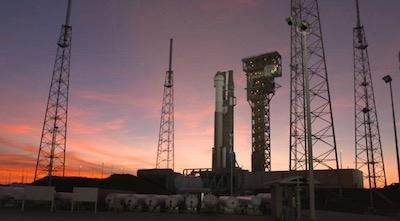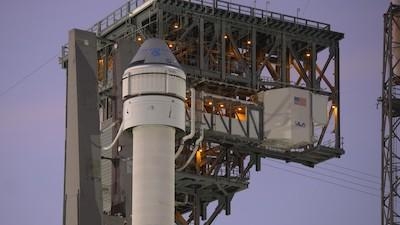Launch Scheduled For December 20 From The Central Florida Coast
The first orbital flight of Boeing's CST-100 Starliner aircraft is set to December 20, launching from Cape Canaveral Air Force Station in Florida, and from start to finish, Aerojet Rocketdyne will play a major role in the mission.

Starliner will launch on a United Launch Alliance Atlas V rocket from Space Launch Complex 41 at Cape Canaveral Air Force Station in Florida. About 31 minutes after launch, Starliner will reach its preliminary orbit. It is scheduled to dock to the space station at 8:08 a.m. Saturday, Dec. 21. Starliner will carry about 600 pounds of crew supplies and equipment to the space station and return some critical research samples to Earth with a parachute-assisted landing at White Sands Missile Range, New Mexico at 5:47 a.m. Saturday, Dec. 28.
The flight test will provide valuable data on the end-to-end performance of the Atlas V rocket, Starliner spacecraft, and ground systems, as well as in-orbit, docking and landing operations. The data will be used as part of NASA’s process of certifying Boeing’s crew transportation system for carrying astronauts to and from the space station. NASA’s Commercial Crew Program is working with the American aerospace industry through a public-private partnership to launch astronauts on American rockets and spacecraft from American soil for the first time since 2011.
Aerojet Rocketdyne propulsion hardware is featured on all phases of the upcoming OFT mission, from launch to atmospheric re-entry, extending a legacy that dates to the dawn of the space age. Aerojet Rocketdyne propulsion systems will enable the mission, which calls for an uncrewed Starliner spacecraft to dock with the International Space Station, conduct in-orbit system checkouts, and then return home for a parachute-aided landing.
“We’re incredibly proud that Boeing entrusted us to provide the propulsion for this critical national capability,” said Eileen Drake, Aerojet Rocketdyne CEO and president. “This historic mission will lay the foundation for launching our astronauts from American soil once again.”
A dual-engine Centaur powered by two RL10 engines manufactured in West Palm Beach, Florida, will be making its debut on the United Launch Alliance Atlas V rocket during the Starliner OFT mission. The dual-engine Centaur provides additional thrust to enable safe abort options along the entire ascent profile. Aerojet Rocketdyne AJ-60A solid rocket boosters will provide a total of more than 750,000 pounds of thrust as part of the boost propulsion for the Atlas V.

Aerojet Rocketdyne in-space propulsion will be used to orient and maneuver both the crew module and the service module. Aerojet Rocketdyne thrusters on the service module will also be used to reboost the International Space Station.
Additionally, the composite overwrap pressurant vessels on the launch vehicle, crew module and service module, built by Aerojet Rocketdyne subsidiary ARDÉ, located in Carlstadt, New Jersey, are manufactured based on a long history of proven flight safety and reliability. ARDÉ designs have flown more than 700 times on launch vehicles and spacecraft around the world.
Aerojet Rocketdyne propulsion on the mission includes:
Atlas V Rocket: Two AJ-60A solid rocket boosters that provide more than 375,000 pounds of thrust each, manufactured in Sacramento, California. Helium tanks for the first and upper stages built by Aerojet Rocketdyne subsidiary ARDÉ, located in Carlstadt, New Jersey. Reaction control engines built in Redmond, Washington, and two RL10 engines built in West Palm Beach, Florida, for the dual-engine Centaur upper stage.
Crew Module: 12 reusable thrusters manufactured in Redmond, Washington, which generate a total of 1,200 pounds of thrust to properly orient the spacecraft for re-entry into the atmosphere. Eight pressure control subsystem tanks to store nitrogen, oxygen and nitrox built by ARDÉ.
Service Module: 28 reaction control system engines, which provide 85 pounds of thrust each to enable on-orbit maneuvering and International Space Station reboost. Twenty orbital maneuvering and attitude control engines, providing 1,500 pounds of thrust each, are used for abort, maneuvering and stage separation. Four launch abort engines, with 40,000 pounds of thrust each, are used only in the event of a launch emergency to propel the crew capsule away from the launch vehicle. All of these types of engines are built in Canoga Park, California. Additionally, ARDÉ provides 4 fuel, 4 oxidizer and 2 pressurant service module tanks.
“Safe, reliable astronaut access to low-Earth orbit is critical for the future of a robust deep space exploration program,” added Drake. “The upcoming Orbital Flight Test builds on the successful test of Starliner’s launch abort system in November and paves the way for the first Starliner flight test with astronauts on board.”
Starliner was developed under a NASA-industry partnership to leverage commercial capabilities and practices to launch astronauts from U.S. soil for the first time since the retirement of the space shuttle in 2011.
(Images provided with NASA and Aerojet Rocketdyne news releases)
 ANN's Daily Aero-Term (04.25.24): Airport Rotating Beacon
ANN's Daily Aero-Term (04.25.24): Airport Rotating Beacon ANN's Daily Aero-Linx (04.25.24)
ANN's Daily Aero-Linx (04.25.24) Klyde Morris (04.22.24)
Klyde Morris (04.22.24) Airborne 04.24.24: INTEGRAL E, Elixir USA, M700 RVSM
Airborne 04.24.24: INTEGRAL E, Elixir USA, M700 RVSM Airborne 04.22.24: Rotor X Worsens, Airport Fees 4 FNB?, USMC Drone Pilot
Airborne 04.22.24: Rotor X Worsens, Airport Fees 4 FNB?, USMC Drone Pilot




